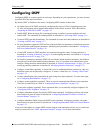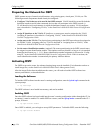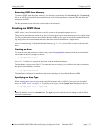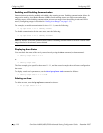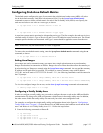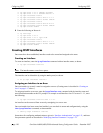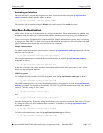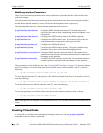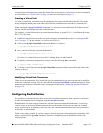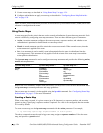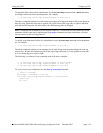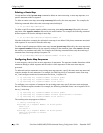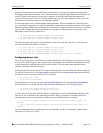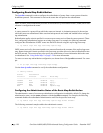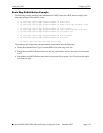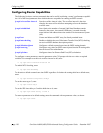
Configuring OSPF Configuring OSPF
OmniSwitch 6800/6850/9000 Advanced Routing Configuration Guide December 2007 page 1-23
Accepted network design theory states that virtual links are the option of last resort. For more information
on virtual links, see “Virtual Links” on page 1-9 and refer to the figure on page 1-9.
Creating a Virtual Link
To create a virtual link, commands must be submitted to the routers at both ends of the link. The router
being configured should point to the other end of the link, and both routers must have a common area.
When entering the ip ospf virtual-link command, it is necessary to enter the Router ID of the far end of
the link, and the area ID that both ends of the link share.
For example, a virtual link needs to be created between Router A (router ID 1.1.1.1) and Router B (router
ID 2.2.2.2). We must:
1 Establish a transit area between the two routers using the commands discussed in “Creating an OSPF
Area” on page 1-17 (in this example, we will use Area 0.0.0.1).
2 Then use the ip ospf virtual-link command on Router A as shown:
-> ip ospf virtual-link 0.0.0.1 2.2.2.2
3 Next, enter the following command on Router B:
-> ip ospf virtual-link 0.0.0.1 1.1.1.1
Now there is a virtual link across Area 0.0.0.1 linking Router A and Router B.
4 To display virtual links configured on a router, enter the following show command:
-> show ip ospf virtual-link
5 To delete a virtual link, enter the ip ospf virtual-link command with the area and far end router infor-
mation, as shown:
-> no ip ospf virtual-link 0.0.0.1 2.2.2.2
Modifying Virtual Link Parameters
There are several parameters for a virtual link (such as authentication type and cost) that can be modified
at the time of the link creation. They are described in the ip ospf virtual-link command description. These
parameters are identical in function to their counterparts in the section “Modifying Interface Parameters”
on page 1-22.
Configuring Redistribution
It is possible to learn and advertise IPv4 routes between different protocols. Such a process is referred to
as route redistribution and is configured using the ip redist command.
Redistribution uses route maps to control how external routes are learned and distributed. A route map
consists of one or more user-defined statements that can determine which routes are allowed or denied
access to the network. In addition a route map may also contain statements that modify route parameters
before they are redistributed.
When a route map is created, it is given a name to identify the group of statements that it represents. This
name is required by the ip redist command. Therefore, configuring route redistribution involves the
following steps:



